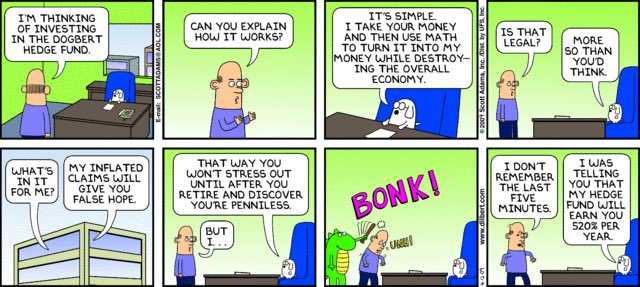
Sums up how a lot of traders behave. Animals clicking buttons.





 This concept of process versus outcome was first introduced to me when I read the book, “More Than You Know”, by Michael Mauboussin. It was also discussed in the books written by the brilliant authors Michael Covel and Mark Douglas.
This concept of process versus outcome was first introduced to me when I read the book, “More Than You Know”, by Michael Mauboussin. It was also discussed in the books written by the brilliant authors Michael Covel and Mark Douglas.
The best way to explain the concept is using the following examples, which involves the game black jack (the only card game I know).
1) Good Process/Good Outcome
The cards you are dealt add up to 12. You have the choice to stay or hit. You chose to hit and receive a 9-blackjack.
The equivalent scenario, in my view, in the stock market is that you see a stock in a downtrend, so, following your rules, you short it. The stock ends up falling another 40% before turning around.
2) Good Process/Bad Outcome
The cards you are dealt add up to 12. You have the choice to stay or hit. You chose to hit and you get a 10 -bust.
In the stock market this is comparable to buying a stock that is in an uptrend, (more…)

1. Bulls make a little. Bears make a little. Pigs get slaughtered
In other words, do not be a greedy trader. If you are a bull, don’t expect to get in at the bottom and out at the top. If you are a bear, don’t expect to pick an exact market top and ride a market all the way down to the lowest low. Thinking otherwise allows the destructive “greed” emotion to take over. Greed has been the ruin of many traders.
2. Any fool can get into a market, but it’s the real pros that know when to get out
Indeed, market entry is certainly an important element of successful trading. However, exiting the trade is paramount. Many times a traders will allow a market to “go against” him or her for way too long and way too far–meaning big trading losses. See next item.
3. Use protective buy and sell stops
One of the major mistakes many traders make is not using protective buy and sell stops when they enter a trade. Or, traders may pull their protective stop, “hoping” the market will turn in their favor. Don’t be fooled into using “mental stops.” Determining where to place protective buy and sell stops BEFORE market entry is one of the best money-management tools available. (more…)
